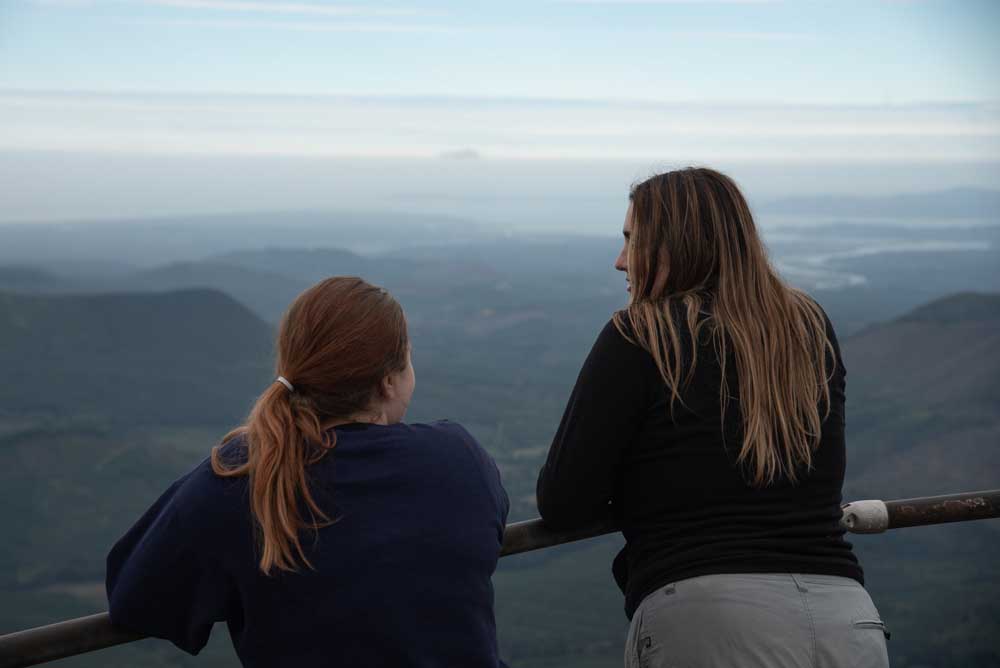Saddle Mountain, back open to hikers, is rich in surprises
Published 9:00 am Saturday, March 9, 2024

- Macy Bell, left, and Auri Potter look out from the 3,288-foot summit toward the Lewis and Clark River and Pacific Ocean.
On a summer day when fog clings to the higher peaks above the Oregon Coast Range, Saddle Mountain ghosts out of the clouds.
The peak is a handsome vista, the tallest in Clatsop County, a nudge above 3,200 feet.
At times, local citizens may take the mountain for granted, as is frequently a human trait. We are busy people, our days full of obligations. We drive by, oblivious to our surroundings. But the mountain and its surrounding park offer a dialogue with nature, in a verdant nest of fir, hemlock and cedar.
The mountain reopened last year after an extended closure. Now, hikers can return to the trail and surrounding park. When occasional snows lay a white cloak over the mountain, one can imagine a poet, scampering for a pad, ink and a brush.
The poet may just write a haiku, something like this: Beneath the peak’s shadow / mountain salutes raven’s flight / eyes ablaze with wonder.
This mountain is alive with some of the rarest and oldest species of wildflowers, lichens and mosses in the state. A few, such as the Saddle Mountain bittercress and early blue violet, can be found in late spring and early summer.
The early blue violet is a favorite of the rare Oregon silverspot butterfly, which was reintroduced to the area in 2018. Add the Cope’s giant salamander, the Alaska long-awned sedge, the Willamette Valley larkspur and a half-dozen others and this place is home to a rare assembly of flora, fauna and avian life.
Saddle Mountain is rich in surprises.
The trek isn’t the hardest in the region, but requires a good picnic lunch and generates a bit of heavy breathing. As a bird flies, the mountain hears, strong and tall and ancient.
Those brave enough to scale the peak are rewarded by watching a bevy of raptors and tiny songbirds. Listen to their squawks and protests as they scamper for leftovers.
On a clear day, Mount Hood, Mount St. Helens, Mount Adams and, of course, Mount Rainier rise above the clouds. The Pacific Ocean is just to the west, endless somehow in its water world, and Tillamook Head overlooks the grand vista close by.
This mountain was created some 15 million years ago after a series of volcanic eruptions. Lava flows were converted into igneous stone and the mountain was born.
The Chinook and Clatsop-Nehalem people came here first, habituating the seashore for thousands of years. A later newcomer was Capt. Meares, who in 1788 named the mountain Mont de la Selle.
There is a park surrounding the peak, the Saddle Mountain State Natural Area. Drive 7 miles up a winding road from U.S. Highway 26, lined with handsome evergreen trees, to reach the trailhead.
The 2.5-mile trail to the top has seen plenty of foot traffic. In places, it is eroded — with loose gravel and slick detritus — and a traveler must watch their step, but new netting has made footing more stable. Still, it is best to press on carefully and quietly.
Hikers might stumble upon a herd of elk, seen from high above, or a black bear in the distance. Wildlife and birds abound with enough regularity to fill a diary on any bluebird day. And flora and fauna — how many ferns can one count? How many wildflowers? Isn’t this the delight of trekking?
According to a Chinook legend, Thunderbird flew to the top and laid a nest of eggs. They were stolen, rolled down the mountain. In the legend, the eggs were broken open, and the First Peoples spilled out.
Capt. William Clark took another view. It was a cold winter day. The mountain was snowclad: “The after part of the day fair & Cool, fore part of the Day rain hailed & blew hard, The mountain which lies S.E. of this is covered with Snow to day … “
The soldiers of the Corps of Discovery were hungry. Clark recorded his observations and then turned to another reality. His men were starving. First in their minds was food, or lack of it.
And again, on March 5, 1806, “the hunters informed us that the Elk is tolerable plenty near the mountains about nine or ten miles distant.” This was Saddle Mountain, barely visible through the rain.
Aren’t we all explorers when we strike out on a wet winter day and climb to the summit of this ancient mountain?
With luck, Saddle Mountain will remain for another dozen eons, standing proud over our lives, a precipice of distinction. If so, we will still climb its broad shoulders and marvel at Mother Nature.
To reach the trailhead, follow U.S. Highway 26 to Saddle Mountain State Park Road.
Check for updated trail conditions at www.stateparks.oregon.gov.





